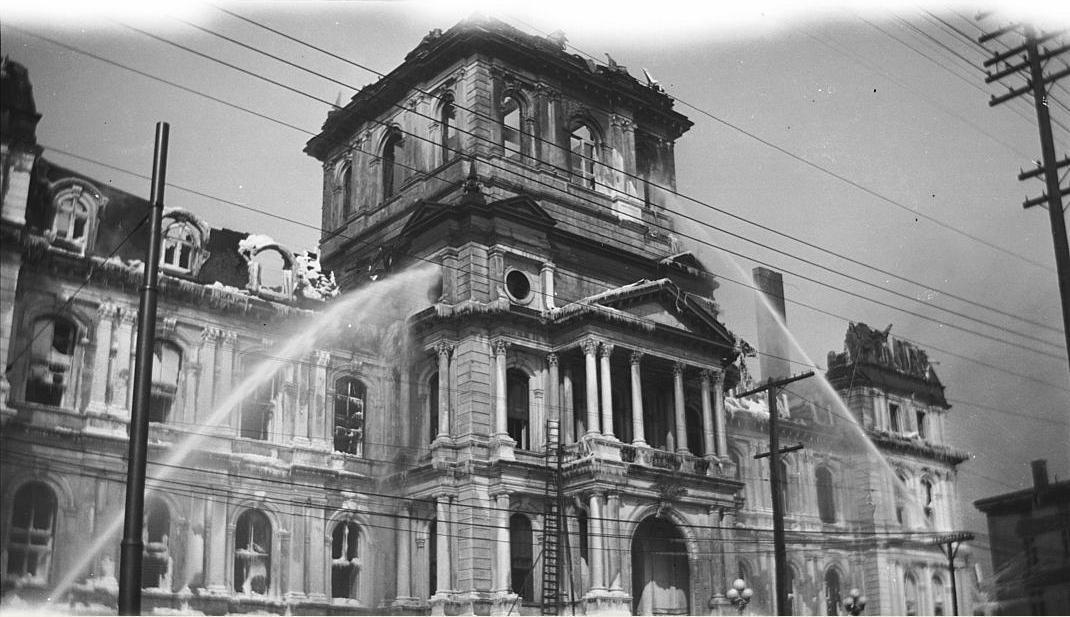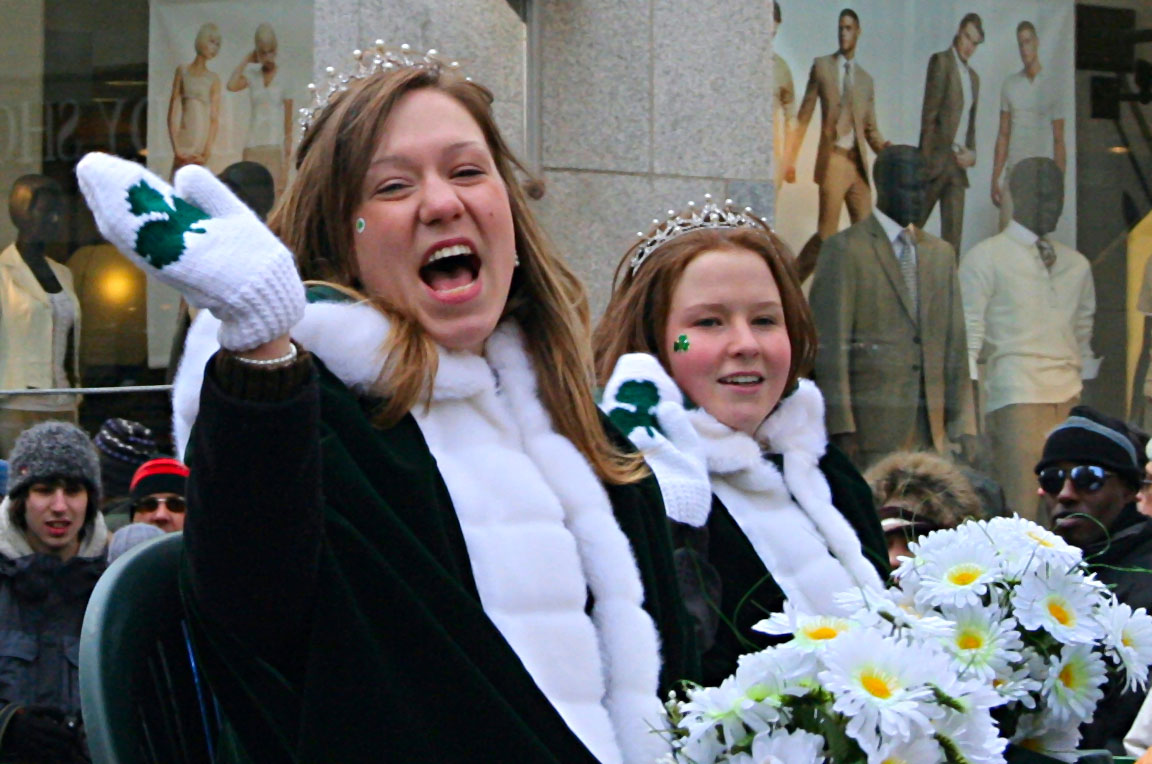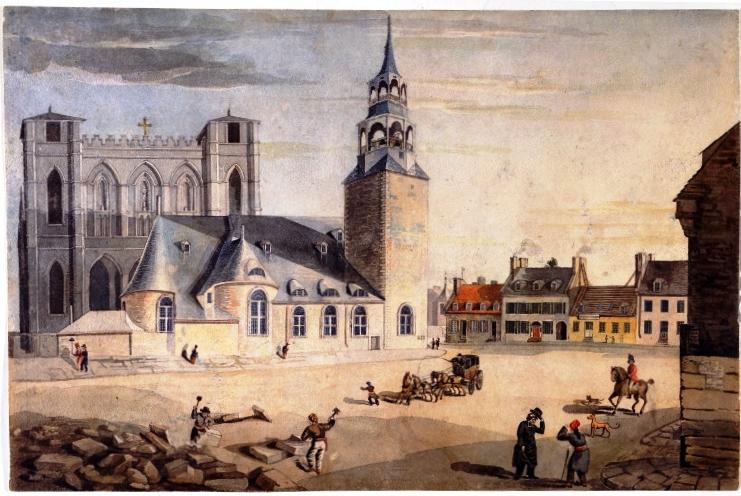|
Notre Dame Street
Notre-Dame Street (officially in french: Rue Notre-Dame) is a historic east-west street located in Montreal, Quebec, Canada. It runs parallel to the Saint Lawrence River, from Lachine to the eastern tip of the island in Pointe-aux-Trembles, then continuing off the island into the Lanaudière region. One of the oldest streets in Montreal, Notre-Dame was created in 1672. The gardens of Château Vaudreuil, which had served as the official residence in Montreal of the Governors General of New France from 1723, fronted Notre-Dame. The street's extension in 1821 led to the demolition of Montreal's Citadel. The Bingham house, which became Donegana's Hotel, was also located on Notre-Dame. In the early 1900s, it was the site of the former Dominion Park. Old Montreal and beyond In Old Montreal, it is the site of such key structures as Montreal City Hall, Palais de Justice de Montréal, the Quebec Court of Appeal, the Château Ramezay, Notre-Dame Basilica and the Saint-Sulpice Se ... [...More Info...] [...Related Items...] OR: [Wikipedia] [Google] [Baidu] |
Montreal City Hall
The five-story Montreal City Hall (French: ''Hôtel de Ville de Montréal'') is the seat of local government in Montreal, Quebec, Canada. It was designed by architects Henri-Maurice Perrault and Alexander Cowper Hutchison, and built between 1872 and 1878 in the Second Empire style. It is located in Old Montreal, between Place Jacques-Cartier and the Champ de Mars, at 275 Notre-Dame Street East. The closest Metro station is Champ-de-Mars, on the Orange Line. As one of the best examples of the Second Empire style in Canada, and the first city hall to have been constructed in the country solely for municipal administration, it was designated a National Historic Site of Canada in 1984. History and architecture Construction on the building began in 1872 and was completed in 1878. The original building was gutted by fire in March 1922, leaving only the outer wall and destroying many of the city's historic records.Rémillard, 80. The architect Louis Parant was commissioned for the re ... [...More Info...] [...Related Items...] OR: [Wikipedia] [Google] [Baidu] |
The Citadel, Montreal
The Citadel of Montreal was a former fortress used to defend the city. It was located at what is now rue Notre-Dame between rue Bonsecours and rue Berri. Smaller than the one in Old Quebec, the Citadel was built by the French in 1690 replacing the 1658 redoubt at Pointe-à-Callière. It consisted of a barrack structure surrounded by wood stakes palisade and located on a hill along the city's fortification wall. A cannon battery added in 1723. The fort was demolished by the British in 1821 to allow for the extension of Notre-Dame Street. See also *Old Montreal Old Montreal (French: ''Vieux-Montréal'') is a historic neighbourhood within the municipality of Montreal in the province of Quebec, Canada. Home to the Old Port of Montreal, the neighbourhood is bordered on the west by McGill Street, on th ... References *Rémillard, François, ''Old Montreal - A Walking Tour'', Ministère des Affaires culturelles du Québec, 1992.Albertine Ferland-Angers, ''La Citadelle de ... [...More Info...] [...Related Items...] OR: [Wikipedia] [Google] [Baidu] |
Joe Beef (restaurant)
Joe Beef is a restaurant in Montreal, Quebec, Canada. The owners describe the cuisine as “Bocusian-Lyonnaise cuisine du marché (French market cuisine).” It's located in the neighbourhood of Little Burgundy Little Burgundy (french: La Petite-Bourgogne) is a neighbourhood in the South West borough of the city of Montreal, Quebec, Canada. Geography Its approximate boundaries are Atwater Avenue to the west, Saint-Antoine to the north, Guy Street ..., in the borough of Le Sud Ouest. History Joe Beef was opened on September 19, 2005 by David McMillan, Frederic Morin, and Allison Cunningham with financial guidance and investment by Jeff Baikowitz and David Lisbona. The restaurant took over the location of Café Miguel. The restaurant's name is a homage to Montreal's infamous Joe Beef, an alias for Charles McKiernan. McKiernan, who owned a tavern that served many lower class laborers in Montreal, “died in his canteen of a heart attack at the age of 54.” McKiernan's g ... [...More Info...] [...Related Items...] OR: [Wikipedia] [Google] [Baidu] |
Black Canadians
Black Canadians (also known as Caribbean-Canadians or Afro-Canadians) are people of full or partial sub-Saharan African descent who are citizens or permanent residents of Canada. The majority of Black Canadians are of Caribbean origin, though the Black Canadian population also consists of African-American immigrants and their descendants (including Black Nova Scotians) and many native African immigrants. Black Canadians have contributed to many areas of Canadian culture. Many of the first visible minorities to hold high public offices have been Black, including Michaëlle Jean, Donald Oliver, Stanley G. Grizzle, Rosemary Brown, and Lincoln Alexander. Black Canadians form the third-largest visible minority group in Canada, after South Asian and Chinese Canadians. Population According to the 2006 Census by Statistics Canada, 783,795 Canadians identified as Black, constituting 2.5% of the entire Canadian population. Of the black population, 11 per cent identified as mixed ... [...More Info...] [...Related Items...] OR: [Wikipedia] [Google] [Baidu] |
English-speaking Quebecer
English-speaking Quebecers, also known as Anglo-Quebecers, English Quebecers, or Anglophone Quebecers (all alternately spelt Quebeckers; in French ''Anglo-Québécois'', ''Québécois Anglophone'') or simply Anglos in a Quebec context, are a linguistic minority in the francophone province of Quebec. According to the 2011 Canadian census, 599,225 people (around 7.7% of population) in Quebec declare English as a mother tongue. When asked, 834,950 people (about 10.7% of the population) reported using English the most at home. The origins of English-speaking Quebecers include immigration from both English-speaking and non English-speaking countries, migration from other Canadian provinces, and strong English language education programs in Quebecois schools. This makes estimating the population of those who identify as English-speaking Quebecers difficult. Population Statistics Canada uses census data to keep track of minority language communities in Canada. It has recorded ' ... [...More Info...] [...Related Items...] OR: [Wikipedia] [Google] [Baidu] |
Little Burgundy
Little Burgundy (french: La Petite-Bourgogne) is a neighbourhood in the South West borough of the city of Montreal, Quebec, Canada. Geography Its approximate boundaries are Atwater Avenue to the west, Saint-Antoine to the north, Guy Street to the east, and the Lachine Canal to the south. The adjacent neighbourhoods are the borough of Ville-Marie and downtown Montreal to the north and northeast, Griffintown to the southeast, Pointe-Saint-Charles to the south, and Saint-Henri to the west. The neighbourhood comprises the former city of Sainte-Cunégonde and Saint-Joseph's ward. Origin There are differing accounts of the origin of the name Little Burgundy (''Petite-Bourgogne''). A surveyor's map of 1855 identifies a property called Bourgogne, owned by the heirs of the Hon. Louis Guy (brother of Étienne Guy, for whom Guy Street was named). The property corresponds to the areas bounded today by Rue des Seigneurs, Rue Notre-Dame, Rue Saint-Martin, and Rue Saint-Antoine. Offici ... [...More Info...] [...Related Items...] OR: [Wikipedia] [Google] [Baidu] |
École De Technologie Supérieure
École de technologie supérieure (ÉTS) is a public engineering faculty in Montreal, Quebec, Canada. Founded in 1974, the École de technologie supérieure is a constituent of Université du Québec system. Specialized in applied teaching in engineering and technology transfer to companies, where professors, engineers and researchers who are recognized for their practical, industrial and innovative approaches. In any given year, 25% of all engineers receiving a diploma from an engineering school or faculty in the province of Quebec graduate from the ÉTS. Hence, it is ranked first in Quebec and second in Canada for the total number of engineering diplomas awarded annually. Facilities The main address of ÉTS is 1100 Notre-Dame Street West in Montreal's Griffintown neighbourhood, the site of a former O'Keefe Brewery, which was transformed to house the school. It has four buildings devoted to education programs and research activities (and another is planned for opening in 2 ... [...More Info...] [...Related Items...] OR: [Wikipedia] [Google] [Baidu] |
Sir George-Étienne Cartier National Historic Site
The Sir George-Étienne Cartier National Historic Site (french: Lieu historique national de Sir-George-Étienne-Cartier) is a historic house museum in Old Montreal commemorating the life and accomplishments of Sir George-Étienne Cartier. This reconstitution of the adjoining homes of the Cartier family features the architectural heritage left by the upper middle class of 19th-century Montreal, along with interpretive activities and theatrical performances. It was designated a National Historic Site of Canada National Historic Sites of Canada (french: Lieux historiques nationaux du Canada) are places that have been designated by the federal Minister of the Environment on the advice of the Historic Sites and Monuments Board of Canada (HSMBC), as being ... in 1964. References External links * Old Montreal George-Étienne Cartier Historic house museums in Quebec Museums in Montreal National Historic Sites in Quebec Houses in Montreal Cartier {{Canada-muse ... [...More Info...] [...Related Items...] OR: [Wikipedia] [Google] [Baidu] |
Saint-Sulpice Seminary (Montreal)
The Saint-Sulpice Seminary (French:Vieux Séminaire de Saint-Sulpice) is a building in Montreal, Quebec, Canada. It is the second oldest structure in Montreal and was declared a National Historic Site of Canada in 1980. It is located in the Ville-Marie Borough in the Old Montreal district, next to Notre-Dame Basilica on Notre-Dame Street, facing Place d'Armes. The seminary is a classic U-shaped building featuring a palatial style and includes an annex. Saint-Sulpice Seminary was founded in 1657 by the Society of Priests of Saint Sulpice, who have been the sole owner of the building since its creation. Construction began in 1684 by François Dollier de Casson, superior of the Sulpicians, and was completed in 1687, although later additions, such as the clock, were completed by 1713. It was dedicated to the education of secular priests and to mission work among native peoples in New France. Clock The façade of the building is adorned with a clock, constructed and installed in ... [...More Info...] [...Related Items...] OR: [Wikipedia] [Google] [Baidu] |
Notre-Dame Basilica (Montreal)
, image = Basílica de Notre-Dame, Montreal, Canadá, 2017-08-11, DD 26-28 HDR.jpg , imagesize = 280px , landscape = , caption = The church building's exterior, 2017 , pushpin map = Montreal , coordinates = , location = 110, rue Notre-Dame OuestMontreal, Quebec, CanadaH2Y 1T2 , denomination = Roman Catholic , previous denomination = , churchmanship = , membership = , attendance = , website Basilique Notre-Dame, former name = , bull date = , founded date = , founder = , dedication = Mary , dedicated date = July 1, 1829 , consecrated date = , cult = , relics = , events = , past bishop = , people = , status = Minor basilica , ... [...More Info...] [...Related Items...] OR: [Wikipedia] [Google] [Baidu] |
Château Ramezay
The Château Ramezay is a museum and historic building on Notre-Dame Street in Old Montreal, opposite Montreal City Hall in Montreal, Quebec, Canada. Built in 1705 as the residence of then-governor of Montreal, Claude de Ramezay, the Château was the first building proclaimed as a historical monument in Quebec and is the province's oldest private history museum. It was designated a National Historic Sites of Canada in 1949. Over the years, the Château changed owners and functions several times, with Ramezay's descendants selling the manor to the fur-trading Compagnie des Indes. Continental army headquarters From 1775, it became the Canadian headquarters for the Continental Army when it seized Montreal. Benjamin Franklin stayed there overnight in 1776, while trying to raise troops to fight for the Americans in the American Revolutionary War. Governor's residence again After the conquest until 1849 the house was again used as a governor's residence, this time by the Britis ... [...More Info...] [...Related Items...] OR: [Wikipedia] [Google] [Baidu] |
Palais De Justice De Montréal
The Palais de justice is a courthouse in Montreal, Quebec, Canada. It is located at 1 Notre-Dame Street East in the Old Montreal neighbourhood of the Ville-Marie borough. It was completed in 1971. Though located in the Old Montreal historic district, it is an international style structure, featuring the outdoor sculpture ''Allegrocube.'' The black metal and granite building is adjacent to the Champ de Mars square. It was designed by Montreal architects Pierre Boulva and Jacques David, whose other prominent Montreal projects included 500 Place D'Armes, Théâtre Maisonneuve, the Dow Planetarium and the Place-des-Arts, Atwater and Lucien-L'Allier metro stations. ''Allegrocube'' Created by Charles Daudelin in 1973, ''Allegrocube'' is a cube-shaped abstract sculpture outside the Palais, 2.4 m in height, made of bronze. Older courthouses The current Palais de justice de Montréal is the third building on Notre-Dame Street in Old Montreal to bear that name. The first was th ... [...More Info...] [...Related Items...] OR: [Wikipedia] [Google] [Baidu] |









